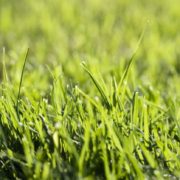How high you should allow the grass on lawns to reach before cutting it is perhaps the most frequently asked question about lawn care that people have. And, “How much of the grass blade should be removed when you are cutting grass?” is a natural companion to that first question. So let’s tackle both queries below.
A Rule of Thumb
How high should you cut the grass when you mow? Well, there is a general rule of thumb for determining what the grass height should be on your lawn. An optimal height for a cool-season grass generally is about 2 1/2 inches. And at each mowing, you should only be removing about the top 1/3 of the grass blade. Consequently, a good time to mow lawns is when your grass is about 3 2/3 inches high.
It is especially recommended that you stick to this rule of thumb in fall (and, to a lesser degree, in spring, but see below). In summer, meanwhile, if can’t remember the measurements, err on the side of mowing at a greater height. It is not a bad idea, in fact, to choose one of the higher settings on your lawnmower wheels when the weather starts getting really hot, and just mow at that height until we approach the fall season and the weather starts to cool off a bit.
Explanation of the Rule of Thumb
Why are 2 1/2 inches an optimal grass height, generally? Well, what you are striving for is a balance. On the one hand, mowing the grass is like “pinching” a garden plant to stimulate rugged growth. So if you are letting the grass get tall, you are not mowing very much, which means you are passing up opportunities to stimulate good grass growth and make your lawn healthier and more attractive. But if you cut the grass too short (known as “scalping,” for obvious reasons), you stress it.
Take note that it is the height that the grass has attained that should determine when it is time to mow: it is your lawn’s way of giving you a cue (straight from the horse’s mouth, so to speak). It would be arbitrary to establish a schedule for mowing based on the length of time between mowings. For instance, advising someone to “mow every other week” fails to take into account the growing conditions during that period of time. For example, rainfall stimulates growth in lawns, so the presence or absence of rain will have a great impact on mowing frequency.
While the 2 1/2-inch height for a cool-season grass is optimal for the fall, it is hardly an absolute figure that must be adhered to throughout the mowing season. If you are trying to get rid of crabgrass, for instance, you may wish to make an adjustment in spring and summer. That is because it is during these seasons that this annual weed (here is what crabgrass looks like) competes for space with your lawn grass.
Some experts recommend keeping lawn grass around 3 inches tall during spring and summer. Why? Because the extra shading that results may inhibit crabgrass enough to keep it in check. In fall, you can go back to maintaining the 2 1/2-inch height, since, by then, frost will have killed the tender crabgrass.
A Trick to Help You Remember These Measurements
So how do you remember this rule of thumb? You do not want to have to go out there with a tape measure to gauge the height of your lawn and determine when it’s time to mow, right?
A tip to make things easier on yourself is to draw a line across one of your lawn mower tires that stands 3 2/3 inches above surface level. Draw an arrow, as well, to indicate which direction is up/down. That way, when you think mowing time might be near, you can just wheel the mower out and see where the grass level stands in relation to your line.
As for achieving that ideal grass mowing height (at the end of the operation), initially, you’ll have to play around with the tire adjustment mechanism on your mower. But once you’ve figured out what slot results in the mowing height you want (namely, leaving the grass at 2 1/2 inches tall), mark that slot so that you’ll always know where it is.



